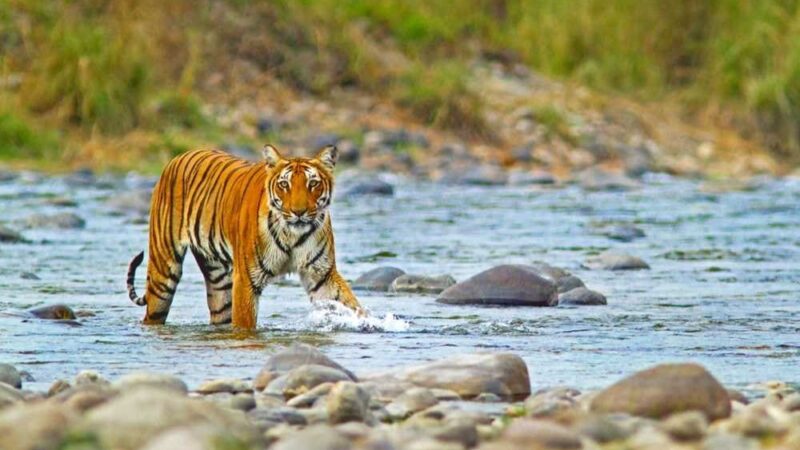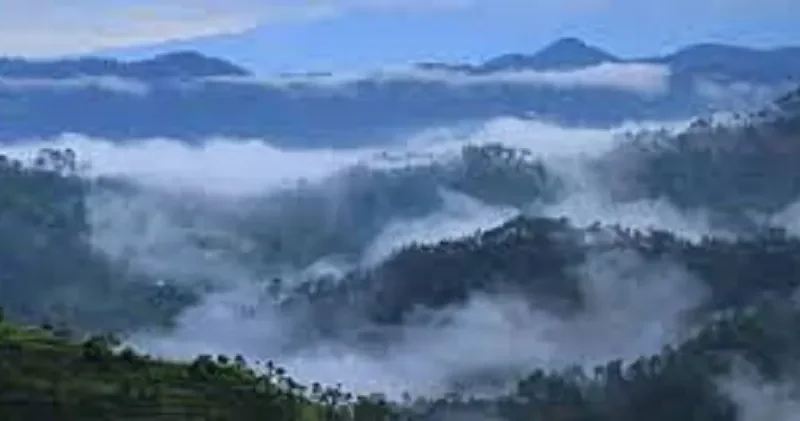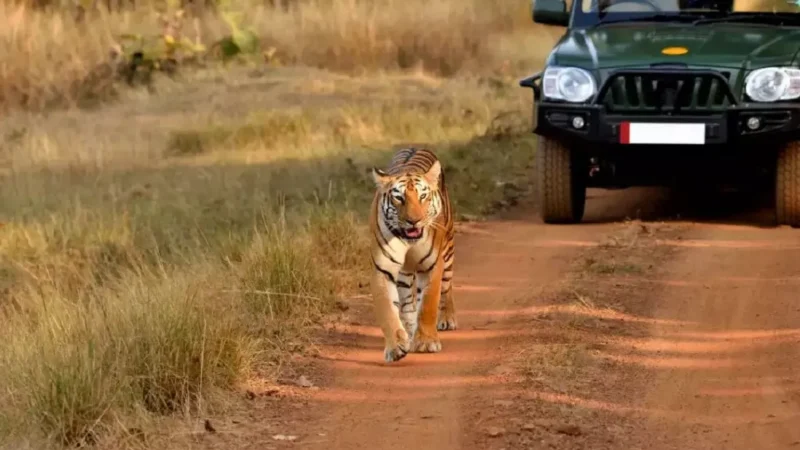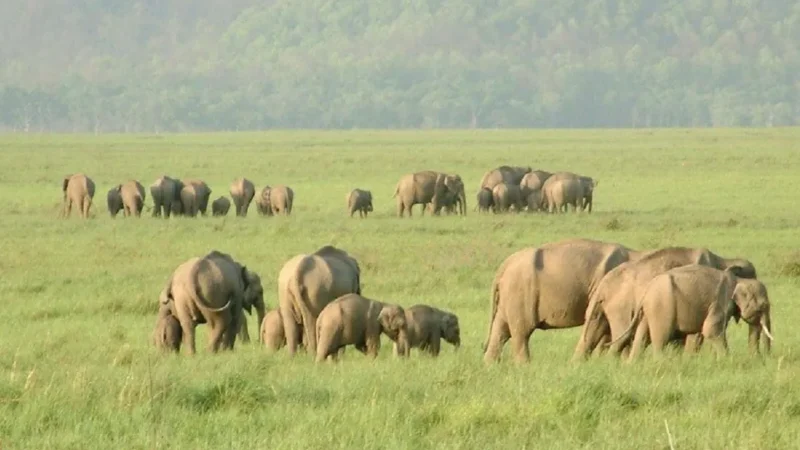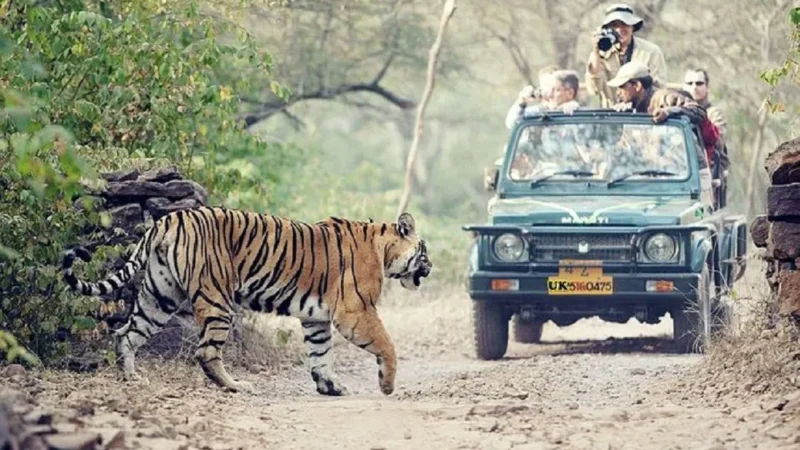Top 10 Wildlife Sanctuary in Uttarakhand

Table of Contents
ToggleUttarakhand Wildlife Sanctuary -
Nestled amidst the majestic peaks of the Himalayas, Uttarakhand is a haven for nature enthusiasts and wildlife lovers. Beyond its serene landscapes and spiritual destinations, this Indian state boasts captivating wildlife sanctuaries showcasing the region’s incredible biodiversity. From elusive snow leopards prowling the heights to the vibrant plumage of Himalayan pheasants, Uttarakhand’s wildlife sanctuaries offer a portal into the heart of the wild. Join us on a virtual journey as we delve into the wonders of these sanctuaries and the fascinating creatures that call them home.
Here are the top 10 wildlife sanctuaries of Uttarakhand, India, with their addresses:
1- Jim Corbett National Park
Here are some details about Jim Corbett National Park:
- Jim Corbett National Park is located in Nainital district, Uttarakhand, India.
- It is the oldest national park in India and was established in 1936.
- The park is named after Jim Corbett, a British hunter and conservationist who played a key role in saving the tiger from extinction in India.
- The park has various animals, including tigers, leopards, elephants, rhinoceroses, deer, and monkeys.
- It is a popular tourist destination for wildlife enthusiasts.
The park is divided into five zones: Dhikala, Bijrani, Jhirna, Durgadevi, and Ramganga. The Dhikala zone is the most popular zone for tiger sightings.
The park is open from November to June. The best time to visit the park is during winter, when the weather is mild and the animals are more active.
The park has several accommodation options, including lodges, cottages, and camping grounds.
Here are some of the things you can do in Jim Corbett National Park:
- Go on a tiger safari: This is the park’s most popular activity and allows you to see tigers and other wild animals in their natural habitat.
- Go for a nature walk: There are several nature trails in the park that you can explore.
- Visit the Jim Corbett Museum: This museum is dedicated to the life and work of Jim Corbett.
- Take a boat ride on the Ramganga River: This is a great way to see the park from a different perspective and spot some animals that live along the river.
2- Sonanadi Wildlife Sanctuary
Here are some details about Sonanadi Wildlife Sanctuary:
- Sonanadi Wildlife Sanctuary is located in Bijnor district, Uttarakhand, India
- It is spread over an area of 301.18 square kilometers.
- The sanctuary was established in 1987 and is a part of the Jim Corbett National Park.
- The sanctuary is home to various animals, including tigers, leopards, elephants, deer, and monkeys.
- It is also home to several birds, including peacocks, hornbills, and eagles.
- The sanctuary is a popular tourist destination for wildlife enthusiasts.
The sanctuary is divided into three zones: Sonanadi, Mandal, and Palain. The Sonanadi zone is the most popular zone for tiger sightings.
The sanctuary is open from November to June. The best time to visit the park is during winter, when the weather is mild and the animals are more active.
The park has several accommodation options, including lodges, cottages, and camping grounds.
Here are some of the things you can do in Sonanadi Wildlife Sanctuary:
- Go on a tiger safari: This is the park’s most popular activity and allows you to see tigers and other wild animals in their natural habitat.
- Go for a nature walk: There are several nature trails in the park that you can explore.
- Visit the Sonanadi Interpretation Centre: This center provides information about the flora and fauna of the sanctuary.
- Take a boat ride on the Sonanadi River: This is a great way to see the park from a different perspective and spot some animals that live along the river.
3- Askot Wildlife Sanctuary
The Askot Wildlife Sanctuary is a protected area in the Pithoragarh district of Uttarakhand, India. It’s situated in the northeastern state, close to the international border with Tibet, China. The sanctuary covers diverse landscapes, including forests, alpine meadows, and high-altitude areas. Here’s some more information about the Askot Wildlife Sanctuary:
Geography and Landscape: The sanctuary spans an area of approximately 600 square kilometers and ranges in elevation from around 1,800 meters to over 6,000 meters above sea level. This wide altitude range contributes to the sanctuary’s rich biodiversity and diverse ecosystems.
Flora and Fauna: Askot Wildlife Sanctuary is home to various flora and fauna adapted to the Himalayan ecosystem. You can find various species of trees, shrubs, and alpine plants in its lower and higher reaches. The sanctuary is also home to wildlife, including snow leopards, Himalayan black bears, musk deer, bharal (blue sheep), serow, pheasants, and other birds.
Avian Diversity: The sanctuary is a haven for birdwatchers, as it hosts various bird species due to its varying altitudes and habitats. Bird enthusiasts can spot monal pheasants, koklass pheasants, and Himalayan griffons.
Cultural Significance: Besides its natural beauty, Askot also has cultural significance. The area is home to several villages inhabited by local communities with unique traditions, customs, and ways of life. The sanctuary’s surroundings include historical sites like the Askot Musk Deer Sanctuary, which was established to protect the endangered musk deer.
Accessibility: The sanctuary is accessible from Pithoragarh, the nearest major town. The roads leading to the sanctuary might only sometimes be in the best condition, especially during the winter months, so it’s advisable to check local conditions before planning a visit.
4- Binsar Wildlife Sanctuary
Here are some details about Binsar Wildlife Sanctuary:
- Binsar Wildlife Sanctuary is located in Almora district, Uttarakhand, India.
- It is spread over an area of 45.59 square kilometers.
- The sanctuary was established in 1988 and is a part of the Nanda Devi Biosphere Reserve.
- The sanctuary is home to various animals, including Himalayan tahr, leopards, langurs, and several species of birds.
- It is also home to several medicinal plants.
- The sanctuary is a popular tourist destination for wildlife enthusiasts and hikers.
The sanctuary is located in the Garhwal Himalayas and is surrounded by mountains. The highest peak in the sanctuary is Nanda Devi East, which is 7,816 meters tall.
The sanctuary is open from April to October. The best time to visit the park is during the spring and autumn when the weather is mild. The park has several accommodation options, including lodges, cottages, and camping grounds.
Here are some of the things you can do in Binsar Wildlife Sanctuary:
- Go on a nature walk or trek: There are several nature trails and treks in the park that you can explore.
- Visit the Binsar Devta Temple: This temple is dedicated to Binsar Devta, the local deity of the area.
- Take a boat ride on the Kosi River: This is a great way to see the park from a different perspective and spot some animals that live along the river.
5- Govind Pashu Vihar Wildlife Sanctuary
The Govind Pashu Vihar Wildlife Sanctuary is a protected area in Uttarakhand, India’s Uttarkashi district. It is part of the larger Govind National Park, known for its diverse and rich biodiversity. Here’s some more information about the sanctuary:
Geography and Landscape: The sanctuary covers an area of around 957.969 square kilometers and encompasses a wide range of altitudes, ranging from approximately 1,300 meters to over 6,320 meters above sea level. This vast elevation range contributes to the sanctuary’s varied ecosystems, including alpine meadows, temperate forests, and high-altitude areas.
Flora and Fauna: Govind Pashu Vihar Wildlife Sanctuary is home to various plant and animal species. The lower regions feature lush forests with oak, rhododendron, and pine trees. The landscape transitions to alpine meadows and rocky terrain as you move higher. The sanctuary is known for its floral diversity, with numerous wildflowers and medicinal plants.
Regarding wildlife, the sanctuary is home to various animals, including the Himalayan tahr, musk deer, snow leopard, black bear, brown bear, and various pheasants and other bird species.
Avian Diversity: The sanctuary is a paradise for birdwatchers, as it hosts a wide range of avian species due to its diverse habitats. Species like the western tragopan, Himalayan monal, koklass pheasant, and more can be spotted here.
Scenic Beauty: The sanctuary is renowned for its stunning natural beauty, including snow-capped peaks, glistening rivers, and serene alpine landscapes. The Tons River flows through the sanctuary and adds to the picturesque scenery.
Accessibility: The sanctuary is accessible from towns like Uttarkashi and Sankri. The roads leading to the sanctuary might be challenging, especially during the winter months, so it’s advisable to check road conditions and weather before planning a visit.
Trekking and Adventure: The sanctuary offers opportunities for trekking and adventure enthusiasts. Treks like the Har Ki Dun trek and the Kedarkantha trek pass through the sanctuary, allowing visitors to explore the breathtaking landscapes and witness the diverse wildlife.
6- Nanda Devi National Park
Here are some details about Nanda Devi National Park:
- Nanda Devi National Park is located in Chamoli and Pithoragarh districts, Uttarakhand, India.
- It is spread over an area of 5,866 square kilometers.
- The park was established in 1982 and is a part of the Nanda Devi Biosphere Reserve.
- The park is home to various animals, including snow leopards, musk deer, Himalayan tahr, and several species of birds.
- It is also home to several glaciers and snow-capped peaks.
- The park is a popular tourist destination for nature lovers and hikers.
The park is located in the Garhwal Himalayas and is surrounded by mountains. The highest peak in the park is Nanda Devi, which is 7,816 meters tall.
The park is closed from November to May due to heavy snowfall. The best time to visit the park is during summer when the weather is mild.
The park has several accommodation options, including lodges, cottages, and camping grounds.
Here are some of the things you can do in Nanda Devi National Park:
- Go on a nature walk or trek: There are several nature trails and treks in the park that you can explore.
- Visit the Nanda Devi Temple: This temple is dedicated to Nanda Devi, the local deity of the area.
- Take a boat ride on the Rishi Ganga River: This is a great way to see the park from a different perspective and spot some animals that live along the river.
7- Valley of Flowers National Park
Here are some details about Valley of Flowers National Park:
- Valley of Flowers National Park is located in Chamoli district, Uttarakhand, India
- It is spread over an area of 87.50 square kilometers.
- The park was established in 1982 and is a part of the Nanda Devi Biosphere Reserve.
- The park is home to various flowers, including Brahma Kamal, which is considered sacred in Hinduism.
- It is also home to several animals, including Himalayan tahr, musk deer, and leopards.
- The park is a popular tourist destination for nature lovers and photographers.
The park is located in the Garhwal Himalayas and is surrounded by mountains. The highest peak in the park is Nanda Devi, which is 7,816 meters tall.
The park is open from June to October. The best time to visit the park is during the monsoon months, when the flowers bloom.
Here are some of the things you can do in Valley of Flowers National Park:
- Go on a nature walk: There are several nature trails in the park that you can explore.
- Trek to Hemkund Sahib: This is a popular trek that takes you to a gurdwara located in the mountains
- Visit the Ghangaria Village: This village is located in the park and is an excellent place to stay and explore.
8- Kedarnath Wildlife Sanctuary
The Govind Pashu Vihar Wildlife Sanctuary is a protected area in Uttarakhand, India’s Uttarkashi district. It is part of the larger Govind National Park, known for its diverse and rich biodiversity. Here’s some more information about the sanctuary:
Geography and Landscape: The sanctuary covers an area of around 957.969 square kilometers and encompasses a wide range of altitudes, ranging from approximately 1,300 meters to over 6,320 meters above sea level. This vast elevation range contributes to the sanctuary’s varied ecosystems, including alpine meadows, temperate forests, and high-altitude areas.
Flora and Fauna: Govind Pashu Vihar Wildlife Sanctuary is home to various plant and animal species. The lower regions feature lush forests with oak, rhododendron, and pine trees. The landscape transitions to alpine meadows and rocky terrain as you move higher. The sanctuary is known for its floral diversity, with numerous wildflowers and medicinal plants. Regarding wildlife, the sanctuary is home to various animals, including the Himalayan tahr, musk deer, snow leopard, black bear, brown bear, and various pheasants and other bird species.
Scenic Beauty: The sanctuary is renowned for its stunning natural beauty, including snow-capped peaks, glistening rivers, and serene alpine landscapes. The Tons River flows through the sanctuary and adds to the picturesque scenery.
Accessibility: The sanctuary is accessible from towns like Uttarkashi and Sankri. The roads leading to the sanctuary might be challenging, especially during the winter, so it’s advisable to check road conditions and weather before planning a visit.
Trekking and Adventure: The sanctuary offers opportunities for trekking and adventure enthusiasts. Treks like the Har Ki Dun trek and the Kedarkantha trek pass through the sanctuary, allowing visitors to explore the breathtaking landscapes and witness the diverse wildlife.
9- Gangotri National Park
Gangotri National Park is a protected area in Uttarakhand, India’s Uttarkashi district. It is named after the sacred Gangotri Glacier, considered the Ganges River’s source. The park is known for its breathtaking landscapes, high-altitude ecosystems, and diverse flora and fauna. Here’s more information about Gangotri National Park:
Flora and Fauna: Gangotri National Park is home to various plant and animal species adapted to the harsh Himalayan environment. The lower regions have coniferous forests, including deodar, pine, and fir species. The landscape transitions to alpine meadows and rocky terrain as you move higher.
The park is also home to various wildlife, including Himalayan tahr, snow leopard, Himalayan black bear, red fox, blue sheep (bharal), and numerous bird species such as Himalayan monal, koklass pheasant, and more.
Avian Diversity: The park is a paradise for birdwatchers, as it hosts a wide range of avian species due to its diverse habitats. Species like the Himalayan monal, bearded vulture (lammergeier), golden eagle, and various finches can be spotted here.
Glacial Features: The Gangotri Glacier, considered the source of the Ganges River, is a prominent feature of the national park. It is one of the largest and most accessible glaciers in the region and holds immense religious significance for Hindus.
Pilgrimage and Adventure: The park is renowned for its natural beauty and religious significance. The town of Gangotri is an important pilgrimage site for Hindus, attracting devotees from all over India. Additionally, the park offers opportunities for trekking and adventure, with trails that take you through its stunning landscapes and provide views of majestic peaks.
Conservation Efforts: Gangotri National Park plays a crucial role in conserving the fragile Himalayan ecosystem and protecting the sources of the Ganges River. Conservation efforts focus on maintaining the delicate balance between human activities and the environment and promoting responsible tourism.
Accessibility: The park can be accessed through the town of Gangotri, which serves as a base for visitors. Due to its high altitude and challenging terrain, it’s essential to be well-prepared and follow safety guidelines, especially during treks and hikes.
10- Rishikesh Wildlife Sanctuary
Rishikesh Wildlife Sanctuary, also known as Chilla Wildlife Sanctuary, is located in Dehradun district, Uttarakhand, India. It is spread over an area of 180 square kilometers. The sanctuary was established in 1986 and is a part of the Rajaji National Park.
The sanctuary is home to various animals, including tigers, leopards, elephants, wild boars, and monkeys. It is also home to several birds, including peacocks, eagles, and owls.
The sanctuary is a popular tourist destination for wildlife enthusiasts. The best time to visit the sanctuary is during winter, when the weather is mild.
Some of the things you can do in Rishikesh Wildlife Sanctuary:
- Go on a jeep safari: This is the most popular activity in the sanctuary and allows you to see tigers and other wild animals in their natural habitat.
- Go for a nature walk: There are several nature trails in the sanctuary that you can explore.
- Visit the Chilla Forest Rest House: This rest house is located in the sanctuary and is an excellent place to stay and explore.
I hope this helps!

